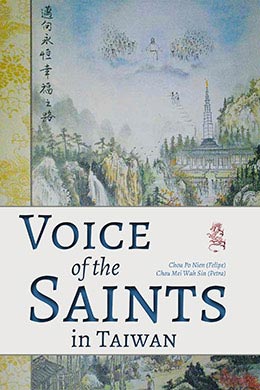Press Forward with Steadfast Faith in Christ
The 921 Earthquake and Surge of Baptisms (1999–2000)
Chou Po Nien (Felipe) (周伯彥) and Chou Sin Mei Wah (Petra) (周冼美華), “Press Forward: The 921 Earthquake and Surge of Baptisms (1999-2000),” in Voice of the Saints in Taiwan, ed. Po Nien (Felipe) Chou (周伯彥) and Petra Mei Wah Sin Chou (周冼美華) (Provo, UT: Religious Studies Center; Salt Lake City: Deseret Book, 2017), 287-322.
The “921 earthquake” in Taiwan, which struck on 21 September 1999, affected everyone on the island, including the members and missionaries of the Church. The Saints were blessed by following the counsel of Church leaders in their emergency preparedness. The inspired counsel before the earthquake and relief efforts that followed are a story of faith and resilience, as the Saints continued to “press forward” with courage, determination, and “steadfast faith in Christ.”[1] There were tremendous changes that came to the Church after the 921 earthquake. These included a spike in missionary success and a surge of convert baptisms throughout the island, including the more than one thousand baptisms in the year 2000 by the Taichung Mission; the creation of additional stakes; and the continued efforts to help each new convert have a friend, fulfill a responsibility, and be nurtured with the word of God. The new century also brought the feature film Legacy, along with “The Living Christ,” which was issued by members of the First Presidency and the Quorum of the Twelve.
921 Earthquake
My Missionaries
On Tuesday, 21 September 1999 at 1:47 a.m. (九二一大地震), a powerful earthquake struck central Taiwan in Jiji (集集), Nantou County, measuring 7.3 on the Richter scale. News reports throughout the world immediately began reporting about this earthquake. The New York Times reported, “Taiwan quake kills hundreds; thousands trapped or injured.”[2] The 921 earthquake, as it became known, was the second-deadliest earthquake in recorded history to hit Taiwan. The media called it the “Quake of the Century,” which was felt from Taiwan to China’s coastal provinces.[3] The Taipei Times reported that “everyone in Taiwan’s central region has been affected by the 921 earthquake. Some have lost sons and daughters, others have lost their homes.”[4] The Taichung mayor, Liao Yung-lai, noted that “many buildings collapsed and there are damages to roads and other infrastructure.” Many were trapped underneath the rubble, while thousands moved into the streets after being awakened by the earthquake.[5] Dennis C. H. Kim, then president of the Taichung Mission, recorded the following:
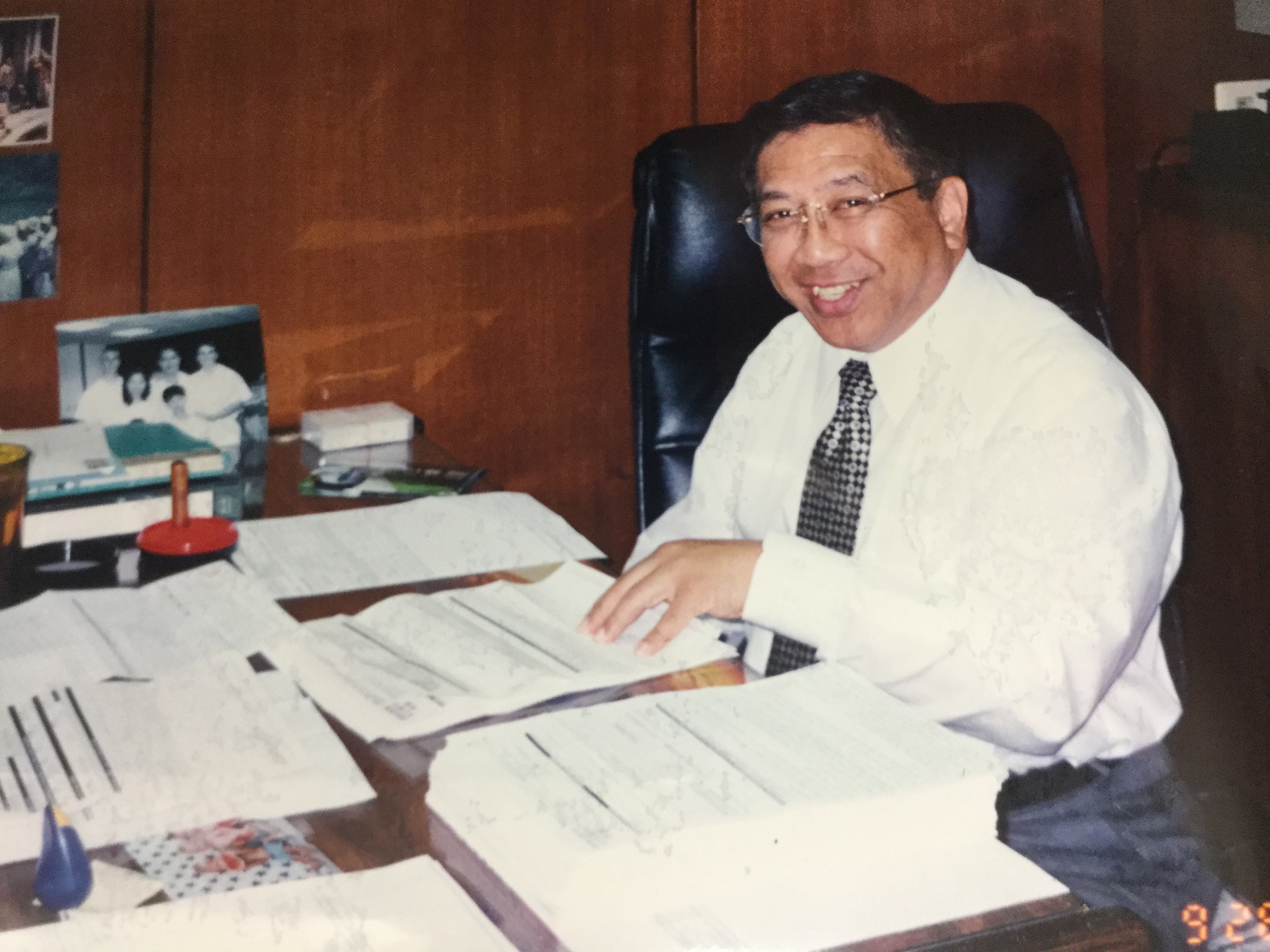 Dennis Kim was the Taichung Mission president in 1999 during the 921 earthquake. He organized his missionaries to assist with relief efforts after the earthquake. Courtesy of Dennis Kim.
Dennis Kim was the Taichung Mission president in 1999 during the 921 earthquake. He organized his missionaries to assist with relief efforts after the earthquake. Courtesy of Dennis Kim.
At [about] 1:45 am on the morning of September 21, I awoke both to violent shaking and Sister Kim yelling for me to get up. The first words I heard were “My Sister Missionaries!” I shook off the sleep left in me and realized that we were in the middle of a major earthquake. . . . I felt like a ping-pong ball in a washer machine. I grabbed [Sister Kim] and dropped to the side of the bed and we said a short prayer for our missionaries and our safety. . . . Our first thoughts were for our missionaries. I called on the intercom to the office elders’ apartment and found out that they were all right. I told them to call all the apartments and find out what happened to all the missionaries around our mission.[6]
President Kim knew he needed to contact the Church right away. Since the members of the Asia Area Presidency in Hong Kong were on their way to Utah for general conference at the time, President Kim called the Missionary Department at Church headquarters to report about the earthquake.[7] President Kim recorded his course of action:
I concentrated on accounting for all our missionaries. The power had disabled our phone system, but our enterprising office elders found a way to shortcut the system using a regular red phone [rotary phone] that we had just brought back the day before from Chingshui. We discovered that the phone system was the only utility working, albeit only one line compared to our normal four. From our discussions with Church headquarters, I received permission for all our missionaries to call their parents and let them know they were okay. So as we checked on each apartment, we told them to call home and also to come to the [Taichung] Stake Center at 10:00 am the next morning for a special meeting that I had called for the Taichung Stake area. . . .
No one slept throughout the remainder of the night. There were aftershocks that in other parts of the world would be classified as a major earthquake by itself.[8]
The next morning, a meeting was held in the parking lot of the Taichung Stake Center at 10:00 a.m., and all but ten missionaries had been accounted for. The ten missing missionaries were living in Puli and Nantou City, the towns closest to the epicenter of the earthquake. Those at the meeting provided an account of the condition of their apartments and received instructions on sanitation practices and remaining healthy despite the lack of running water or electricity. In addition, they were encouraged to return to their areas to help serve those in need and check with the mission office daily for updates and additional instructions.[9]
President and Sister Kim took two of their strongest elders with their bicycles to search for the ten missing missionaries. They drove towards the remote town of Puli, nested in the middle of the mountains. There were collapsed buildings and bridges along the way and road damage and debris everywhere. The mission vehicle was unable to pass Chao Tun, where the road had fallen over five feet down. After last-minute instructions from the Kim’s, Elders Didericksen and Strickling mounted their bicycles and began their thirty-four-kilometer uphill ride to Puli. That afternoon, these elders were able to find the missing missionaries in Puli, who were safe and accounted for.[10]
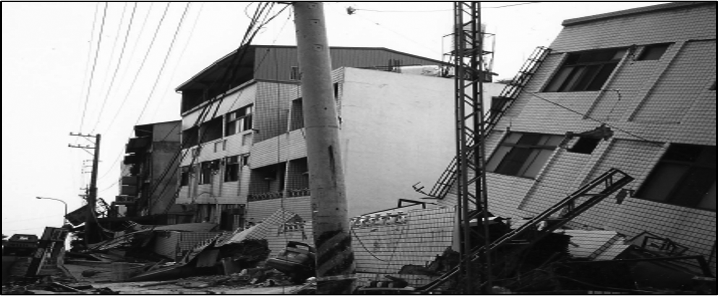 The 912 earthquake in 1999 measured 7.3 on the Richter scale. Courtesy of John Cragum.
The 912 earthquake in 1999 measured 7.3 on the Richter scale. Courtesy of John Cragum.
The Taiwan military and rescue groups from around the world worked together in search-and-rescue efforts and to deliver water, food, and emergency supplies to more than 100,000 people left homeless by this earthquake. Another 12,911 aftershocks were recorded, including one measuring 6.8 on the Richter scale the day after Taiwan President Lee Teng-hui declared a state of emergency on 25 September.[11] The aftershocks leveled a number of buildings already weakened by the original earthquake and also triggered 132 mudslides. Emergency personnel and others had difficulty reaching survivors due to the remote location of the affected areas. The Church provided direct relief and translation services for rescue teams that arrived from other countries.[12] President Kim recorded the following just a few days after the earthquake:
Sister Kim and I took some more critical supplies to Chung Hsing. . . . We decided to go into Nantou and look for President Chen. . . . [His home] was still intact, but his retaining walls had fallen into the banana field below, and his driveway and parking area had separated from the house. . . . He had abandoned his home and by coincidence had come home to get something, so we bumped into him. We spoke about his needs and told him about the supplies that had arrived and were on the way. We asked him about the status of members and their homes. Then we started organizing the way relief supplies and materials would be distributed. . . .
We also went up to Puli to check on the members and missionaries there. . . . Puli was in the worst condition. . . . Hundreds of buildings and homes were totally destroyed. . . .
We found that the members had all gathered at the Nan Kuang Elementary School ground. . . . Members and missionaries were camped at the site in tents, but were in good spirits and were busy helping with the rescue effort. . . . They were happy to see us, and we assured them that additional help was on the way. By the end of the second day following the quake the local priesthood network was fully organized and operational.[13]
President Kim also noted the service rendered by the full-time missionaries from his mission following the earthquake:
I sent several missionary districts to help both at Puli and Nantou. At one point we had over fifty missionaries providing service to the rescue and relief efforts there. Our missionaries were some of the first on the scene because they rode bikes. Because of this, they got through easily compared to cars or trucks, which couldn’t get past the fallen bridges and cracks in the road. Some were inspired to go to the large stadium to see if they could help. The press had started to arrive, and because our missionaries stood out, they were interviewed many times by members of the news media.
Our missionaries were doing many types of service they never dreamed they would be doing. They were pulling victims from fallen buildings, carrying the injured and dead to waiting helicopters, providing translation services, loading and unloading relief trucks, helping to distribute food and water, and even helping victims pitch tents which were to become their temporary homes for the next several days or weeks. Missionaries in less affected areas called on active members, investigators, and inactive members to see if they were safe or needed help. In all, our missionaries provided over four thousand hours of service in the first five days following the earthquake.[14]
Church’s Relief Efforts
Meanwhile, the Church was already in the process of organizing emergency relief efforts. Allen Litster, the director of temporal affairs, provided general instructions and communication between the Asia Area Office, the Taipei Service Center, and Bishop Richard C. Edgley of the Presiding Bishopric. Elder Liang Shih-An (Kent) (梁世安), an Area Authority Seventy, was designated the priesthood leader for the island. Elder John R. Cragun, the Asia Area welfare agent in Hong Kong, coordinated with Chao Chiung Ming (James) (趙炯民) from the Taipei Service Center and Elder Harold Howe, the executive secretary to the Asia Area Presidency.
Elder Cragun arrived from Hong Kong on Saturday to assess the situation and hold a training meeting for all priesthood leaders in Taiwan. He returned the following week with his assistant Elder John Hopkins to provide further training. Emergency funds were immediately authorized to purchase needed emergency supplies to be sent to Taichung and Chung Hsing from Taipei and Kaohsiung. Tang Mei-Lan (Meryl) (湯美蘭) from the Taipei Service Center coordinated the transfer and release of funds. Chao drove down to Taichung to evaluate the situation and met President and Sister Kim, who had just returned from Puli and Nantou, while Liang Shih-Wei (Carl) (梁世威) remained at the Taipei Service Center to coordinate and manage communication.
On 21 September 1999, Chao wrote, “I met President and Sister Kim and their office elders. . . . I was grateful to know that missionaries in Taichung were safe.” The missionaries aided the community by distributing food to homeless families. Chao noted that “there were many homes of the members in Chung Hsing District damaged by this earthquake, . . . so they stayed in the school campus,” arranged by the government, while others stayed at the Chung Hsing or Taichung chapel overnight.[15] The next day, Liang Shih-Wei (Carl) reported that “two trucks of goods from Kaohsiung [had] arrived at the Taichung Mission . . . , includ[ing] 50 boxes of water, 40 tents, 100 sleeping bags, and some quilts, batteries, and a generator.” Liang continued, “From Taipei, a van with some medicines, sanitary supplies, canned foods, breads, flashlights, stoves, and butane gas is on its way to Taichung . . . [and] Chung Hsing.” A communication center had been established in the Taipei Service Center, with Elder Liang and President Chou Wen-Tsung (周文宗) (chairman of the Regional Welfare Committee) establishing plans for the relief efforts.[16]
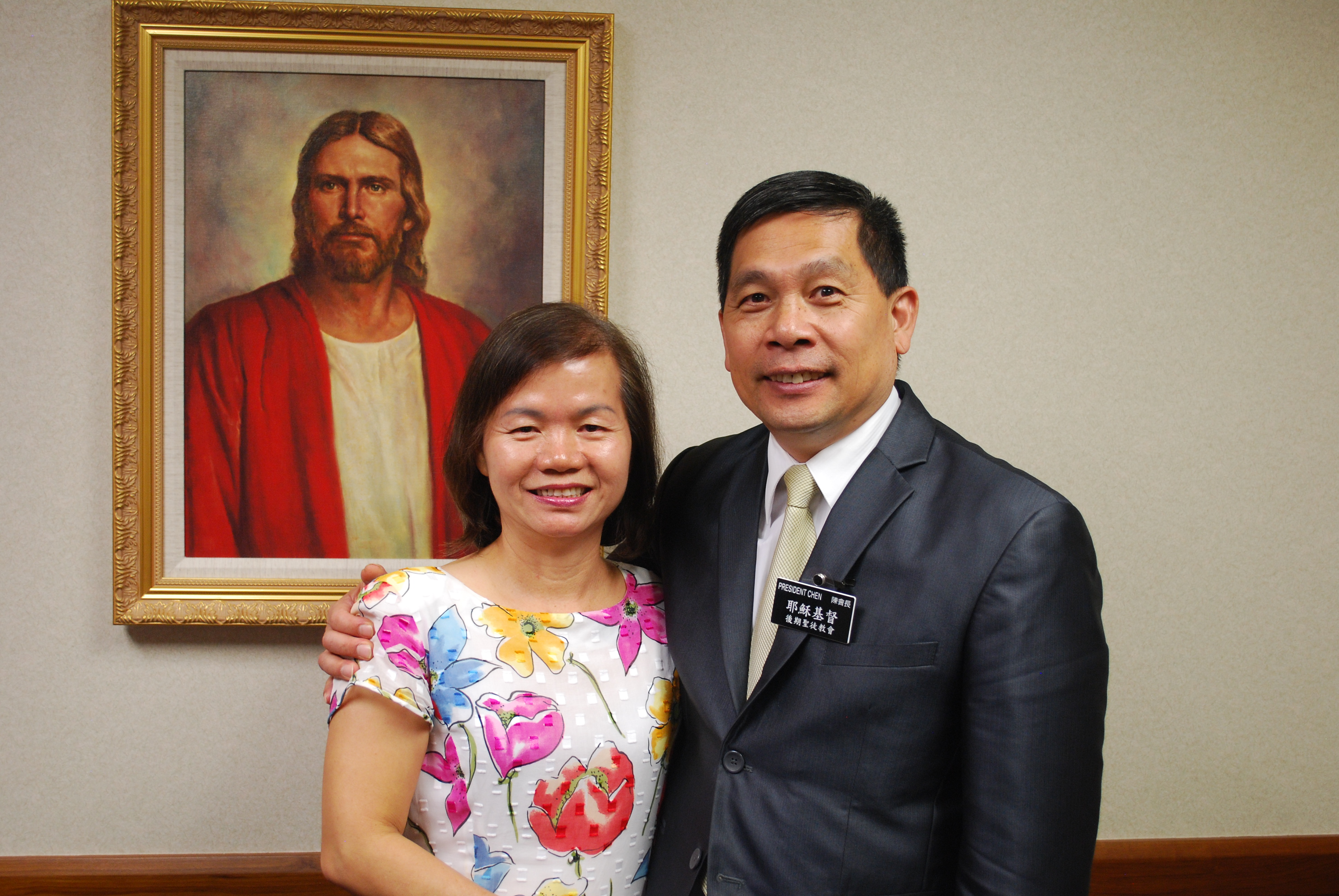 Chen Ting Hui and his wife, Chen Li Mei-Chen, in 205. President Chen was the district president of the Chung Hsing District and helped coordinate relief efforts following the 921 earthquake in 1999. Courtesy of Chou Po Nien (Felipe).
Chen Ting Hui and his wife, Chen Li Mei-Chen, in 205. President Chen was the district president of the Chung Hsing District and helped coordinate relief efforts following the 921 earthquake in 1999. Courtesy of Chou Po Nien (Felipe).
Chao accompanied President and Sister Kim as they drove out to visit the most affected area, where some homes had collapsed and most had structural cracks. Chao reported that in the Chung Hsing District, “President Chen Ting Hui (陳定輝) was pleased to see us. He told us that all his district members were safe except for house damages.”[17] Food and supplies arrived that evening, and Chen coordinated the distribution of supplies. Chao also noted:
[Missionaries were sent] to [the] Nantou emergency rescue operation center to participate in volunteer services. There were many soldiers, policemen, and volunteers from various social and religious organizations. We saw truckloads of food, bottled water, [and] medical supplies ready to be distributed. . . . Helicopters were there to help those remote areas and places not able to be approached through ground transportation. We were told that one of our missionaries was interviewed by three different local TV station reporters.
I saw [local] leaders . . . with shipments of food and water. . . . President Kim kept sending his missionaries to Nan-Tou and Pu-Li to provide community service. . . . I am grateful to see many faithful members and leaders.[18]
Wang Lu Pao (王綠寶) reported that emergency supplies were immediately purchased or gathered by members in Taipei and sent to those in central Taiwan. Water, food, blankets, and other supplies were collected and rushed to those in affected areas.[19] Lee Shih-Jung (李世榮)—recently called as the Kaohsiung Stake president in 1999, just before the 921 earthquake—noted that he was contacted by the Area Presidency, who transferred funds to the Kaohsiung Stake in the south within a day of the earthquake to purchase water and supplies to be sent off to central Taiwan. Similarly, local leaders in Taipei also purchased and gathered needed emergency supplies in the north to send to central Taiwan. Miraculously, the Chung Hsing chapel, which was in the midst of the earthquake area, was still standing and was used to distribute aid.[20]
The First Presidency also approved a donation of 25,000 US dollars to be given to the Taiwan earthquake committee.[21] Additional funds were requested and authorized by the Church for local needs. Liang Shih-Wei (Carl) observed that Church members throughout the Taipei and Taoyuan area were invited to donate tents, sleeping bags, and blankets and bring them to the Taipei Service Center the following Sunday. In addition, under the direction of Elder Kent Liang, priesthood leaders announced a special fast on Sunday, with fast-offering donations to go towards the relief funds for this earthquake. Cash donations and donated supplies both accumulated quickly in Taiwan.[22]
Many members and former missionaries in the United States and other countries who learned of the earthquake contacted Elder John Cragun at the area office in Hong Kong with a desire to help their fellow Saints in Taiwan. These members were encouraged to donate to the fast-offering funds of the Church. By the following Monday, 27 September, Church members in Taiwan had donated a significant amount of goods, and by the next Sunday, 2 October, they had gathered a substantial amount of fast offerings. President Kim reported the following regarding the situation on the ground and relief efforts:
Many members, investigators, and their relatives and neighbors who have fled their homes were camping on the church grounds and in chapels. Other people were sleeping wherever they could find an open spot away from the buildings. There were even people camping on medical strips on the major roads throughout the city. Many of them had only the clothes on their backs. . . . In Puli, it is estimated that fifty percent of the buildings need to be rebuilt; another thirty percent will need major repairs, and the balance will need minor repairs or can be left as is. Nantou had similar estimates. With this background it was comforting to know that the Church was aware of our plight and had set in motion its welfare system to help victims of disasters. I received calls from Hong Kong and Utah inquiring about the status of the mission, and informing me as to the amount of extra money that was being released for us to handle immediate needs during this crisis.[23]
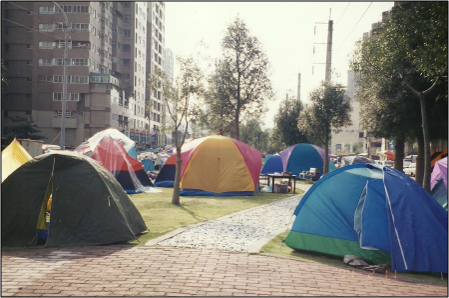 Many lived in tents while buildings were evaluated for safety. Courtesy of John Cragum.
Many lived in tents while buildings were evaluated for safety. Courtesy of John Cragum.
Kim also received a call from Kaohsiung to notify him that “their stake was sending two trucks of relief supplies to Taichung.” Kim said that this was the first of many acts of service that would come from fellow Saints throughout Taiwan.[24] He added: Help came from Changhua, Hsinchu, Chupei, Taipei, Keelung, and Kaohsiung, as well as from the Service Center in Taipei. In fact so much help was arriving that the three Priesthood leaders here (President Chou Wen-Tsung of the Taichung Stake, President Chen Ting Hui of the Chung Hsing District, and myself) had to gracefully decline additional help for our members and missionaries. The same happened with other government and charitable organizations in this area. Now we had the task to organize, inventory, and distribute all that we have received.[25]
The Asia Area welfare agent, Elder John Cragun, briefly visited Taiwan to survey the situation immediately after the earthquake. He then returned the following week with Elder John Hopkins to visit and provide training to local leaders from 29 September to 2 October. Cragun noted that four training sessions were held and “the use of emergency assistance funds for victims . . . [was] switch[ed] over to the use of fast offering funds.” He also reported that although lack of communication caused delays, leaving many on their own for the first thirty-six hours after the earthquake, members outside the affected area mobilized quickly to send aid and supplies. Finally, Cragun observed that although the Area Presidency had not advocated them before, “72 hour kits . . . were extremely beneficial to many members after they fled their homes in the early morning hours of September 21st.”[26]
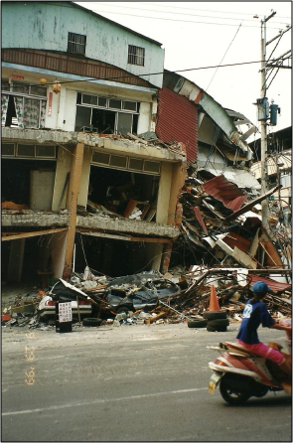 The 921 earthquake and aftershocks destoyed and damaged numerous buildings in 1999. Courtesy of John Cragum.
The 921 earthquake and aftershocks destoyed and damaged numerous buildings in 1999. Courtesy of John Cragum.
The aftermath of this earthquake left 2,415 people dead and 11,305 injured. An estimated 300 billion New Taiwan dollars’ (US $10 billion) worth of damage remained, including severe damage to the Central Cross-Island Highway and 102 major bridges; the earthquake also left 51,711 buildings destroyed and another 53,768 that were severely damaged.[27] The Church reported:
An earthquake . . . killed more than 2,000 people in Taiwan in September. Three members were injured, and the homes of at least 50 members were seriously damaged or destroyed. No missionaries were hurt. . . . Three meetinghouses were used as emergency shelters. Local Church leaders used fast-offering funds to purchase water, food, and bedding for members in need, especially in the hardest-hit areas of Puli and Nant’ou.[28]
The Church also had an opportunity to touch the lives of those of other faiths, as members participated in various service projects to support other community and religious leaders in the affected areas. President Kim shared the following experience with a local religious organization:
About a week after the earthquake, I received a call from the vice-president of the Tzu Chi Buddhist Benevolent Society in Central Taiwan in the morning. He said, “President Kim, we are an organization of older people who have money and good will. We are in the process of building temporary housing for the victims of the earthquake. But we lack the muscles to pour cement and build the foundations for those homes. We know that you have young missionaries here. Can you help us?”
I said, “How many young men do you need?”
“About forty.”
“When do you need them?”
“The cement trucks start arriving at 2:00 this afternoon.”[29]
Kim concluded the telephone conversation with the vice president of the Tzu Chi Buddhist Benevolent Society by saying, “I will try and give you the help you need.” He then immediately went to work. He said the following of the situation:
I called my Assistants and had them call four zones of missionaries to bike to Chung Hsing and help the Buddhists build their temporary housing. Some of them biked over two hours, but by 2:00 they were all working side by side with their Buddhist brothers. Some of our missionaries came from families in the construction business, so they were even of greater help. For two weeks they worked together and built a great relationship. Later, the Vice-President confided in me, “We actually had asked some other churches to help, but they declined saying that they needed to take care of their own members. Your Church truly is a church where love has no bounds.” This story was even printed in the Tzu Chi Foundations’ magazine, so we got great coverage from that. I learned that selfless service brings greater rewards, most of which are unexpected.[30]
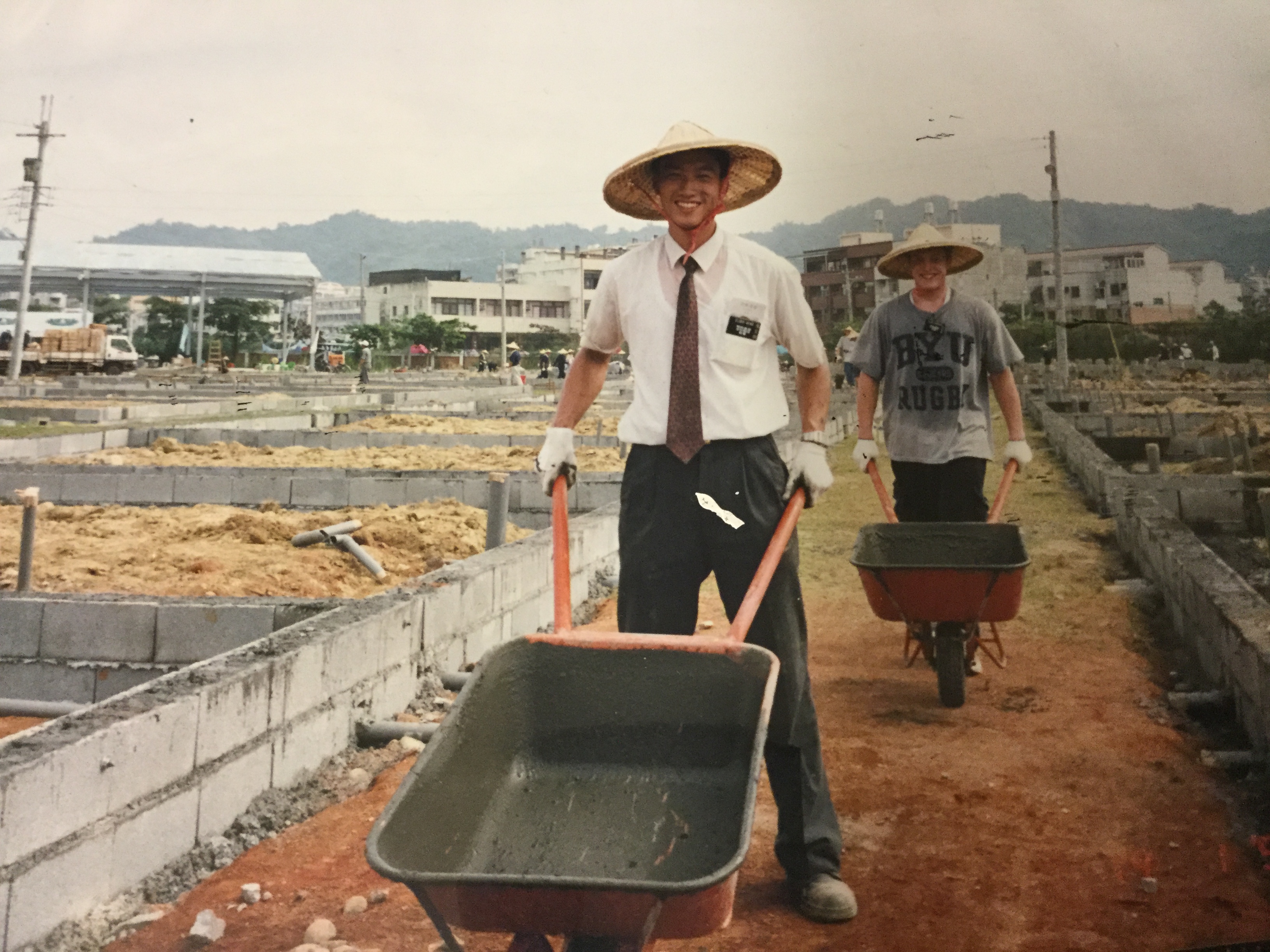 Missionaries from the Taichung Mission assisted local religious and community leaders following the 921 earthquake. Courtesy of Dennis Kim.
Missionaries from the Taichung Mission assisted local religious and community leaders following the 921 earthquake. Courtesy of Dennis Kim.
Chen Ting Hui (陳定輝), then the Chung Hsing Taiwan District president, said that he and President Kim visited members throughout the district. Members first lived at a nearby school and then at the Nantou chapel, mostly in tents for a month, until they began to return to their homes about two months after the earthquake. During the aftermath, the government and the people in the community witnessed the service of the many missionaries. Many joined the Church, and five branches soon turned into nine branches in the Chung Hsing Taiwan District, which soon became a stake. The Church also built many chapels throughout Taiwan after the earthquake, including several in central Taiwan.[31]
Self-Reliance and 72-Hour Kits
Many members of the Church in central Taiwan noted the inspired counsel of local Church leaders who encouraged the Saints to prepare the 72-hour emergency kits just a few months before the 921 earthquake. They also recognized the hand of the Lord in inspiring local leaders to teach self-reliance principles, encourage members to store food and emergency supplies, and help each family have a 72-hour emergency kit in their homes.
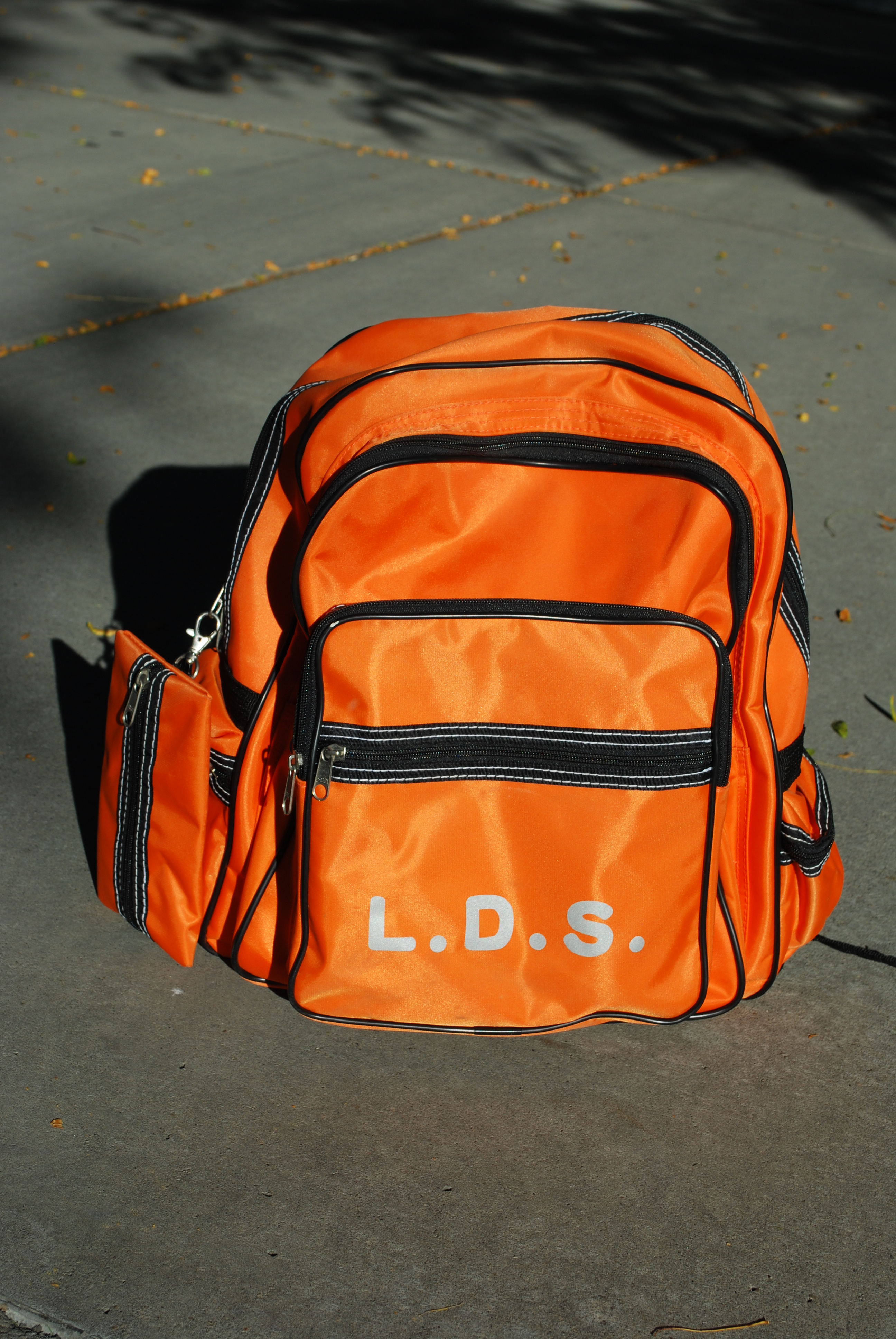 LDS 72-hour emergency bags used during the 921 earthquake by members and missionaries in 1999. Courtesy of Chou Po Nien (Felipe).
LDS 72-hour emergency bags used during the 921 earthquake by members and missionaries in 1999. Courtesy of Chou Po Nien (Felipe).
In central Taiwan, local Church leaders had encouraged members to prepare both temporally and spiritually before the earthquake. As part of the temporal preparation, members were encouraged to prepare a 72-hour emergency kit and have some food storage. Under the direction of Chou Wen-Tsung (周文宗), the stake president of the Taichung Taiwan Stake, the stake Relief Society president, Sister Tsao Fang-Ching (曹芳菁), coordinated efforts with the various wards to help each active family have a complete 72-hour kit. Bright orange backpacks with the letters “LDS” inscribed were made available for local Church members to purchase. Wards and branches placed orders for these orange backpacks, which included materials like emergency blankets, rain ponchos, flashlights, water, and other emergency supplies.[32]
Sister Tsao recalled how grateful the members were for the inspiration of local leaders and the blessing of having the 72-hour kits distributed just a few days or weeks prior to the earthquake. Although she did not understand its importance at the time, she learned the importance of “obeying the counsel of priesthood leaders and following the guidance of the Holy Ghost” for our temporal and spiritual safety.[33] Sister Juan Tsai Chia-Hsiu (阮蔡佳秀), from Taichung, shared her experience of serving as a visiting teacher to a less-active sister. Sister Juan visited her regularly and later gave her a 72-hour kit. Following the 921 earthquake, this sister returned to the Church and shared her gratitude for the visiting teaching program of the Church.[34]
Since the Chung Hsing Taiwan District had been recently divided from the Taichung Taiwan Stake, it also encouraged members to get their 72-hour kit. Chen Ting Hui (陳定輝), then the Chung Hsing Taiwan District president, said that his district began working together with the Taichung Stake to prepare the 72-hour emergency kits. Chen noted that while they did not know an earthquake was coming at the time, when the earthquake came, the members were blessed to grab their 72-hour kits they had just finished preparing.[35] His wife, Sister Chen Li Mei-Chen (陳李美娟), was grateful they received the emergency kits a week or two before the earthquake.[36] For those who listened to the counsel of Church leaders, the 72-hour kits were an important preparation ahead of the devastating 921 earthquake.[37]
President and Sister Kim, of the Taichung Taiwan Mission, also felt impressed to order a 72-hour bag for each missionary apartment when the stake began to make preparations. The Kims encouraged missionaries to keep the 72-hour bag near the entrance to their apartment and to add a few bottles of water as well. They delivered the 72-hour bag to the last missionary apartment just one week before the earthquake hit.[38]
When the 921 earthquake struck, many members grabbed their orange backpacks and fled into the streets with the masses to avoid being inside a building in case it collapsed. Because the earthquake occurred in the middle of the night, resulting in power outages, many people were trapped inside their dark apartment buildings, unable to find their way down damaged staircases and out into the streets. In many cases, Church members or the missionaries were the only people in their entire apartment complex to have a working flashlight, which they pulled out of their 72-hour emergency bag. As such, they became the default leaders for their apartment building, as they used their flashlights to help other residents find their way out of the building.[39]
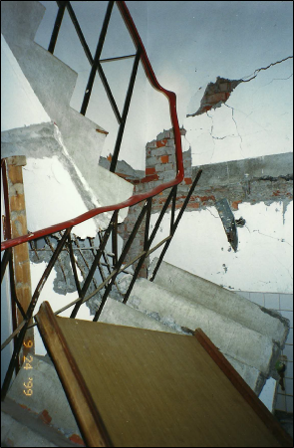 Stairways in numerous buildings were damaged during the 921 earthquake in 1999. Courtesy of John Cragum.
Stairways in numerous buildings were damaged during the 921 earthquake in 1999. Courtesy of John Cragum.
The Taichung Stake presidency noted that the preparation of the local leaders, members, and missionaries enhanced the presidency’s ability to deal with this major disaster. In a letter of gratitude to Chao Chiung Ming (James) and the Taiwan Service Center staff, the Taichung Stake Presidency explained the following:
September 21 was the most difficult and painful day for citizens in central Taiwan. However, to members living in central Taiwan, we felt [your] endless warmth. In this earthquake disaster, we felt your greatest care and love from your prompt delivery of goods. . . .
Due to the preparation of 72-hour emergency bags and family food storage program [weeks prior to the earthquake], our capability to deal with disasters were enhanced. We express our gratitude to the Lord’s blessings and teachings. The Lord’s mercy has protected us. We have a profound understanding [of] why prophets have repeatedly admonished us the importance of [the] food storage program. We will promote more thoroughly this food storage program in the future because we have learned from this disaster lessons. We expect our brothers and sisters to prepare ourselves in every aspects to face challenges before the Second Coming of Jesus Christ.
[From] all members of the Taichung Stake [we] wanted to express our deep appreciation for your whole support and assistance. . . .
May the Lord leave his peace to all of you.
From the Taichung Stake Presidency.[40]
Local news outlets reported on the people who were prepared with their 72-hour emergency backpack. Later on, a Relief Society leader was featured on the news, showing and discussing the contents of the backpacks. The faith of members in following their local leaders’ counsel to prepare their 72-hour emergency backpacks when they were not yet needed was a blessing to these members during the first few hours after the 921 earthquake.[41] This faithfulness also led to the media attention and subsequent growth in missionary work and convert baptisms in central Taiwan.[42] Sister Chen Li Mei-Chen (陳李美娟) said that the news reports of the “orange LDS bags” caused the police department, the fire department, and other groups to contact the Church to learn how to assemble these 72-hour emergency backpacks, so they could provide information to the community.[43]
Taichung Mission’s One Thousand Baptisms for the Year 2000
After setting a mission baptismal goal to double baptisms and reach one thousand baptisms in the year 2000, President Dennis C. H. Kim, then president of the Taiwan Taichung Mission, was told, “That is a nice baptismal goal, but we also need to be realistic.” Eighteen months earlier, in 1998, President and Sister Kim were called to preside over the Taiwan Taichung Mission. At the time, President Kim heard negative news from former Taiwanese missionaries, who said that one baptism during your mission was good because Taiwan was a hard mission. Although cautioned not to change things too fast, President Kim felt strongly that he needed to immediately create a culture of success among his missionaries by increasing contacts and allowing the Holy Ghost to do the work of conversion.[44]
Double the Number of Baptisms
During President Kim’s first six months as mission president, 186 people were baptized in the Taichung Mission. He reminded the missionaries to be obedient, work diligently, and increase missionary activity by opening their mouths. He sought to develop a culture of success by helping each missionary gain a vision of this work, reminding them of the recent call from the prophet to double baptisms.[45] During a satellite broadcast on 21 February 1999, President Gordon B. Hinckley said, “Last year there were approximately 300,000 convert baptisms throughout the Church. . . . It is wonderful. But it is not enough.” He then added, “I am not being unrealistic when I say that with concerted effort, with recognition of the duty which falls upon each of us, . . . and with sincere prayer to the Lord for help, we could double that number.”[46]
Kim worked to develop a culture of success among his missionaries and the members of the Church in Taichung and surrounding areas. He reported, “In 1999, we baptized 501 converts, which was almost double the number in 1998. In December we brought up the subject [of doubling baptisms] to our missionaries in our Christmas Mission Conference.” The missionaries caught the vision of the prophet and their mission president and set a goal to double baptisms or have one thousand baptisms in the year 2000. The missionaries quoted 1 Nephi 3:7: “I will go and do the things which the Lord hath commanded, for I know that the Lord giveth no commandments unto the children of men, save he shall prepare a way for them, that they may accomplish the thing which he commanded them.”[47]
At the 1999 Christmas mission conference, each missionary signed a card to send to President Hinckley, committing to double baptisms in the year 2000.[48] Wang Jung Ling (王榕翎), a full-time missionary, noted the excitement at this special Christmas mission conference and the desire of the missionaries to be completely obedient to fulfill the prophet’s call to double baptisms. He recalled that one sister missionary noted the goal should actually be 1,002 rather than 1,000, since the mission had 501 baptisms the previous year.[49]
The missionaries and members worked hard towards this goal, setting baptismal services every week. Missionaries contacted new and former investigators as well as part-member families. Some missionaries stopped only briefly for a quick bite on the streets while on their bicycles, only to move on quickly to their next appointment. By November 2000, there were 855 baptisms in the Taichung Mission, about 145 short of their goal. They had five Sundays left in December and doubled their efforts, but no one knew the final count until the very last day.[50] When the office elders received the complete tally late on 31 December, they exclaimed, “60 souls were baptized this last week! Giving us a total of 169 for the month, and 1024 for the year!”[51] Kim recounted:
At 10:30 pm on the 31st of December we got the final count from the office Elders: we had just witnessed a miracle. We had baptized a total of 1,024 converts in the year 2000. Everyone was crying, and as the Elders call[ed] each apartment, there were more tears shed. . . . I learned the power of vision, being strictly obedient, and setting high goals.[52]
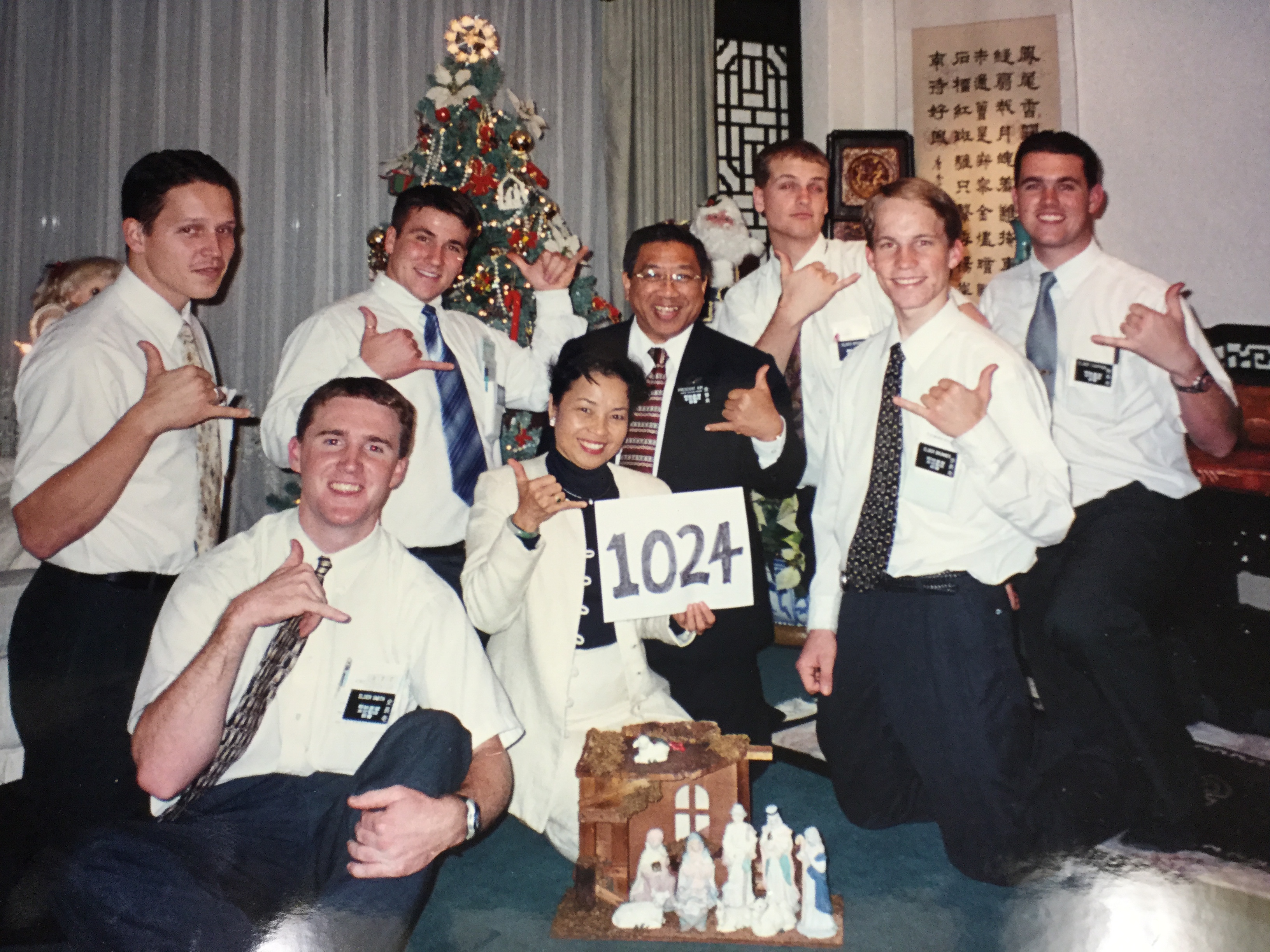 President and Sister Kim with Office elders on 31 December 2000. The Taichung Mission reached its goal to double baptisms, with 1,024 baptisms in the year 2000. Courtesy of Dennis Kim.
President and Sister Kim with Office elders on 31 December 2000. The Taichung Mission reached its goal to double baptisms, with 1,024 baptisms in the year 2000. Courtesy of Dennis Kim.
As the report was sent out to all the missionaries, Kim remarked that he could almost hear his missionaries crying in gratitude for the Lord’s help in accomplishing this miracle. Although it was late at night, President Kim picked up the phone and called President Richard Cook, then the counselor in the Asia Area Presidency over Taiwan, to report they had achieved the goal of 1,024 baptisms in 2000, which was thought to be unrealistic just a year before. President Kim reported that there was silence on the other end of the line, as President Cook was clearly moved by this report and responded in tears, “Congratulations. You are truly the flagship of Asia.”[53]
Although the missionaries were typically not allowed to leave their mission during this time and thus unable to attend the Taipei Taiwan Temple located in the mission to the north, special permission was granted for President and Sister Kim to take all their missionaries for a special session at the Taipei Taiwan Temple.[54] Kim noted, “After reaching last year’s goal of 1,000 convert baptisms, we received special permission to attend the Taipei temple. On January 18, our mission spent our preparation day attending the temple.”[55] Their accomplishment is a great example of humble, dedicated servants of the Lord who were willing to follow the counsel from a prophet, work hard, and rely on the hand of the Lord to bring about his work among the people of Taiwan.[56]
Kim noted that baptisms in his mission doubled the second year and then doubled again the third year after the earthquake. In 2000, one American missionary noted that when he was called to serve in the Taiwan Taichung Mission, he was told not to expect many baptisms. But he did not understand what that meant, because he regularly had baptisms each month of his mission.[57] President Robert D. Murdock, from Utah, was called in 1998 to reopen the Taiwan Kaohsiung Mission,[58] which was created from the Taichung Mission. He also noted the sudden increase in convert baptisms in the south. The division of the mission also led to an increased complement of missionaries. The combined effort of members and missionaries, as well as the positive media attention, helped to increase the harvest of new converts in Taiwan.[59]
New Mission President and Stakes
Several other impressive individuals served as mission presidents in Taiwan during this time period. Of particular note was Chou Wen-Tsung (周文宗), who was called as the first Chinese mission president to preside over the Taiwan Kaohsiung Mission. Chou Wen-Tsung served as a stake president and bishop prior to his call to serve as the first Chinese mission president for the Taiwan Kaohsiung Mission. Chou Wen-Tsung and his wife, Chou Li Su-Hua (周李素華), were baptized in 1978 and 1968 respectively. As a stake president, Chou was also inspired to encourage the members in central Taiwan to prepare their 72-hour emergency kits prior to the 921 earthquake in 1999. In working with the local leaders and members, he understood and often discussed local circumstances and ways the members could assist with missionary work.[60]
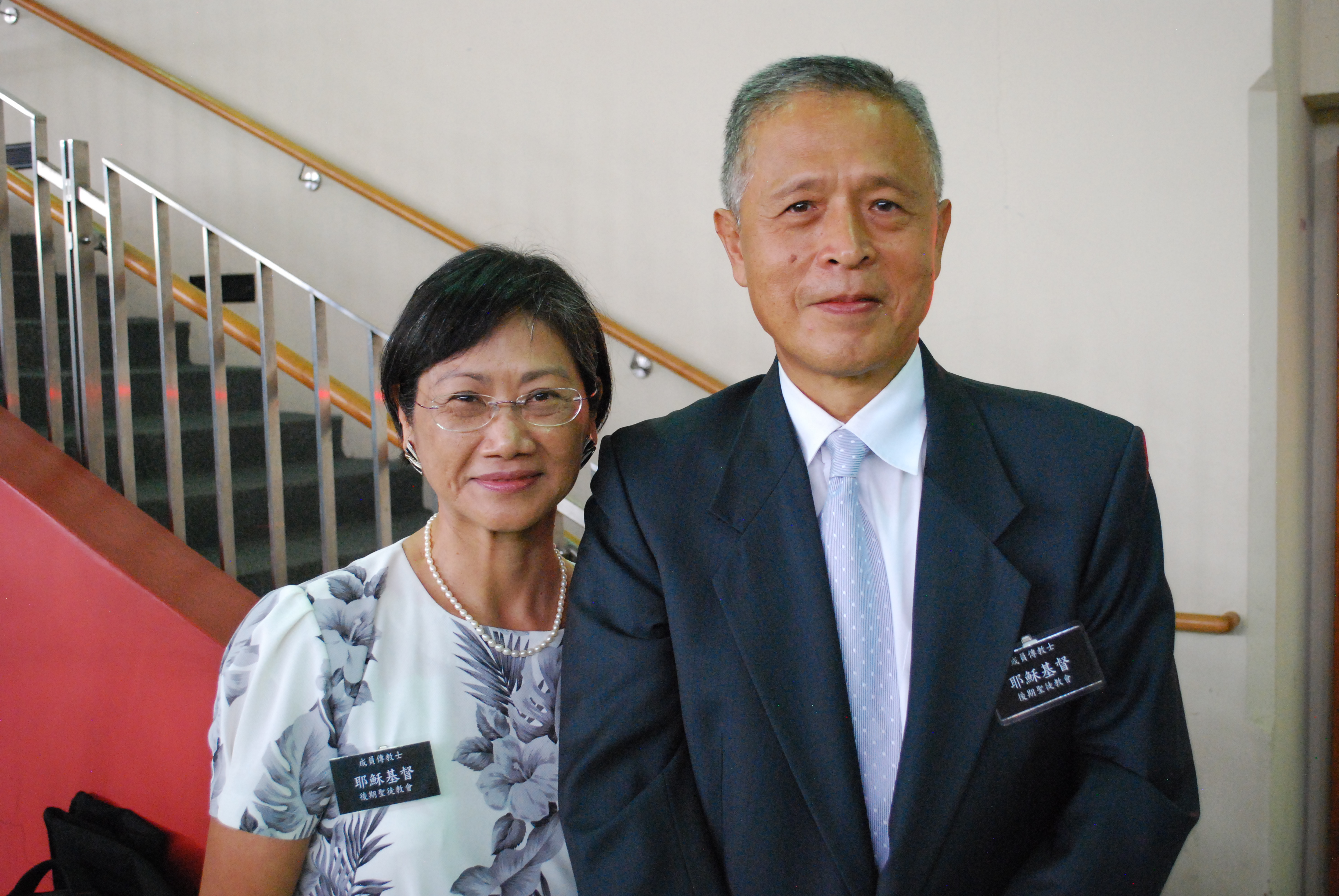 Chou Wen. Tsung and his wife, Chou Li Su-Hua, in 2016. From 2003 to 2006, CHou served as the first Chinese mission president of the Taiwan Kaohsiung Mission. Courtesy of Chou Po Nien (Felipe).
Chou Wen. Tsung and his wife, Chou Li Su-Hua, in 2016. From 2003 to 2006, CHou served as the first Chinese mission president of the Taiwan Kaohsiung Mission. Courtesy of Chou Po Nien (Felipe).
Sister Chou Li Su-Hua’s mother was introduced to the Presbyterian Church but never joined. After LDS missionaries knocked on their door, Sister Chou’s mother and older brother began to study the gospel and were among the early converts in Chiayi. Sister Chou attended church for many years but was not baptized until she was twelve years old. She said, “I was attending church with my mom and everyone assumed I was a member of the Church. I was baptized after someone finally realized I was not yet a member.” In college, Sister Chou was shy and not in the social circles, and her classmates called her a “devil’s girl” because she was in the Mormon Church, and the Chinese word for “Mor” sounded similar to the Chinese word for “devil.” She wondered, “How do they know I am a member of the Church?” She explained her beliefs to a classmate, Chou Wen-Tsung, who was curious about her religion.[61]
Chou Wen-Tsung found it strange that his classmate’s positive demeanor was so different than the reports he heard about her horrible church. He was struck by her comment when she said, “I don’t know why others criticize our Church, because we don’t ever criticize them.” He decided to visit her church and went to the Chin Hua Street chapel, where he sat in the back for several weeks of meetings. He said, “I went to Church and sat in the back for about ten weeks, but no one ever said hi to me. Finally, someone asked me which ward I was visiting from and I told them I was not a member of the Church.” Chou was introduced to the missionaries and was later baptized. He would eventually marry his classmate who introduced him to the gospel. At the time of his call to serve as a mission president, Chou said, “It is a blessing to be called to serve in one’s own country.”[62]
Chen Ting Hui (陳定輝), who served with Chou for many years prior to his call, remembered the training he received from Chou. He noted how diligently Chou worked to turn the Taichung District into a stake when they were serving together. Then, after that goal was accomplished, Chou encouraged the Saints to continue pressing forward, resulting in the creation of the Chung Hsing District, divided from the recently formed Taichung Stake.[63] Chou was a great and capable leader who loved the members and sought to help them work diligently to help build the kingdom. Hsu Ming-Chuan (許明泉), who served as a counselor in the mission presidency during this time, said that Chou knew the local language and culture and encouraged everyone to help with missionary work. As a mission president, Chou also worked with the Pingtung Taiwan District more than other mission presidents, focusing on assisting the local members and leaders of the district. Moreover, Chou focused on encouraging the youth to serve missions.[64]
Besides the hard work and influence of the first Chinese mission president for the Kaohsiung Taiwan Mission, the growth in convert baptisms also lead to the creation of new stakes. The Taoyuan Taiwan Stake, for instance, was created on 8 July 2001, with Chen Cheng Erh (Michael) (陳誠二) called as its first stake president.[65] In central Taiwan, Church membership grew substantially due to the efforts of the members and missionaries following the 1999 earthquake, resulting in the creation of two additional stakes in 2003 and 2004. The Hsinchu Taiwan Stake was created on 14 December 2003, with Hong Wei-Chin (洪偉欽) as the stake president.[66] In addition, the Chung Hsing Taiwan Stake was created on 20 June 2004, with Chen Ting Hui (陳定輝) as the stake president.[67]
A Friend, a Responsibility, and “the Good Word of God”
With the increase of convert baptisms, there was also an increased need to improve the retention of the converts and prepare them to enter the temple. During the October 1997 general conference, President Gordon B. Hinckley spoke of missionary service, retention of converts, and the importance of the temple. After his historic announcement that the Church would “construct small temples,” he spoke on the importance of retaining every new convert.
With the increase of missionary work throughout the world, there must be a comparable increase in the effort . . . to retain every convert who comes into the Church. . . .
I say to bishops throughout the world that with all you have to do . . . you cannot disregard the converts. . . . They need a friend. They need something to do, a responsibility. They need nurturing with the good word of God. . . . I invite you, every one of you, to make this a matter of priority in your administrative work. I invite every member to reach out in friendship and love for those who come into the Church as converts.[68]
Branches and wards throughout Taiwan made a concerted effort to retain the increased number of new converts. One example from the smallest unit in the Kaohsiung Stake illustrates this effort. In the summer of 2000, Chou Po Nien (Felipe) (周伯彥) was called to serve as the branch president of the Kaohsiung Seventh Branch, with about twenty people attending each week. There were only five active elders, and convert retention was below 30 percent, typical for many units in Taiwan.[69] Chou pondered, prayed, and considered the message in the February 1999 Liahona from President Hinckley, which emphasized that every convert needs “a friend, a responsibility, and nurturing with ‘the good word of God’ (Moroni 6:4).”[70] Chou felt impressed to give these converts a responsibility as soon as possible so that they could serve with others who would become their friends and be nurtured by the word of God through Sunday and weekday religious instruction. Each newly baptized sister immediately received a calling to serve as a counselor in one of the auxiliary presidencies a week or two after becoming a member of the Church. This gave the sisters immediate responsibilities and instant friends to watch over and mentor them.[71]
Chou also placed each newly baptized brother on a fast-track plan to prepare for the Melchizedek Priesthood. The Sunday after they were baptized and confirmed, these brethren were immediately ordained to the office of a priest and received a calling. They were mentored, and they passed the sacrament the second week, then prepared to bless the sacrament the third week. These new priests also baptized other new converts and conferred the Aaronic Priesthood when possible. Traditionally, the branch president or bishop would be asked to confer the priesthood and ordain, but Chou felt it was more important to train these new priests and give them opportunities to exercise the priesthood. He often invited new priesthood holders to participate in performing the ordinances as soon as possible. For example, Chou would stand next to a new priest and whisper in his ear what to do and say his first time ordaining another new priest. He believed they learned best by doing.
The Kaohsiung Stake president supported these efforts by coming to the branch to interview prospective elders. These new priests were being prepared to receive the Melchizedek Priesthood by their first stake conference or stake priesthood meeting. The training and mentoring of these new elders would continue as they consecrated oil for the blessing of the sick, helped anoint and provide blessings, and so forth. The same pattern ensued as Chou modeled the ordinance, then stood by and allowed them to perform it for the first time. They learned by doing and then cemented that learning by teaching others just a few months younger in the gospel.[72]
Home and visiting teaching, family home evening groups, ward activities, and potlucks each month also developed friendship and unity among members of the branch. Sunday instruction nourished new converts “with the good word of God.” In addition, those members who were fourteen and older were also invited to seminary or institute. The institute class for the branch grew from two to over thirty in a few weeks. Next, Chou began to prepare several families to receive their temple blessings.[73] While explaining the importance of giving every convert “a friend, a responsibility, and nurturing with the good word of God,” President Hinckley also taught about the importance of the temple when he announced the construction of small temples:[74]
I believe that no member of the Church has received the ultimate which this Church has to give until he or she has received his or her temple blessings in the house of the Lord. . . .
We are determined, brethren, to take the temples to the people and afford them every opportunity for the very precious blessings that come of temple worship.[75]
The Kaohsiung Stake had monthly temple buses that went to the Taipei Taiwan Temple, approximately five to seven hours away. The buses typically departed at 5:00 a.m., allowing members from Kaohsiung to complete one endowment session at the temple and return home that same night. This stake typically provided two temple buses each month but struggled to fill the second bus. The branch president of the Kaohsiung Seventh Branch encouraged all new converts to go to the temple to perform baptisms for the dead as soon as possible. Several families were being prepared for their temple sealings, and the branch set a goal to fill a temple bus on its own.[76]
A few months later, the other wards in the stake filled one bus, and the smallest branch in the stake filled the other temple bus with a few endowed members but also with many new converts going to the temple to perform baptisms for the dead. The spirit of the temple had a marvelous effect upon this small branch. Several of these new members later received their endowments and were sealed in the temple. The temple helped to unify the members of the branch. By 2002, sacrament attendance had increased from twenty to nearly ninety people. Within two years, new convert retention increased from about 30 percent to over 90 percent, and active Melchizedek Priesthood holders went from five to twenty-five, retaining about 90 percent of new elders.[77]
President Wang Chao Yung (王招勇), a new convert who served as Chou’s first counselor, became the next branch president. Wang had been baptized only a couple of years prior and was sealed to his wife and children only a few months before he was called as the bishop of the newly created Kaohsiung Seventh Ward. The smallest branch in the stake had become one of the strongest wards because every member was given a friend and a responsibility and was nurtured by the good word of God to prepare him or her for temple blessings.[78]
Lee Shih-Jung (Robert) (李世榮), the Kaohsiung Stake president, also spoke of the increased faithfulness of the Saints in attending the temple. During his time as a stake president, he sought to have at least one member of the stake presidency at each monthly temple trip. President Lee said that President H. Bryan Richards, then a counselor in the Asia Area Presidency and a member of the Seventy, told him that the members of the stake would be blessed with safe and smooth travel on their monthly temple trip if the stake would have at least three temple buses each month. Lee added that when he became the stake president in 1999, there were barely enough members for two buses, but the stake trusted in the blessing. Bishops focused on temple recommend interviews, members were encouraged to attend monthly, and each ward was invited to fill its own bus. Their faith was rewarded, and they were blessed as promised by President Richards, while they began to fill the existing and additional temple buses.[79]
Legacy and “The Living Christ”
The Church-produced movie Legacy was shown in Taipei on Saturday, 2 September 2000. It was played for both members and nonmembers through the efforts of the Taipei Service Center. A crowd of 2,148 people from Taipei, Taoyuan, Nantou, Hualien, and Taitung attended the three shows that day. This movie was later shown at the Taichung and Tainan Stake Centers. Legacy premiered in 1993 in the Joseph Smith Memorial Building in Salt Lake City, Utah, and since then over 3,600,000 people have seen the movie. The Church announced that it would be available on DVD for purchase at Church distribution centers across the world.[80] Overall, this movie helped the Saints in Taiwan better understand the struggle of early Mormon pioneers and their sacrifice to preserve a legacy of faith.
Earlier that year, on 1 January 2000, the First Presidency and the Quorum of the Twelve Apostles issued “The Living Christ: The Testimony of the Apostles.” To commemorate the birth of the Savior, modern-day prophets and apostles shared their testimony and witness of the living Christ.[81] Furthermore, in November and December of that year, stakes and districts throughout Taiwan held a global Young Women celebration. The theme for this celebration was “Testify of Christ.” Young women and their leaders participated in testimony meetings, musical programs, and other activities in Taipei, Taoyuan, Hsinchu, Taichung, Chung Hsing, Kaohsiung, and Pingtung.[82] These celebration activities strengthened their testimonies of the living Christ and commemorated the birth of the Savior.
Conclusion
Although the 1990s ended in difficult circumstances following the terrible 921 earthquake in Taiwan, area and local leaders were instrumental in helping the members and missionaries “press forward” with faith, courage, and determination. The relief efforts by the Church brought much media attention for the Church, which experienced dramatic growth following the earthquake. The Taiwan Taichung Mission doubled its convert baptisms, with over 1,000 in the year 2000, followed by the creation of new stakes. This tremendous growth was accompanied by efforts to retain and strengthen every new convert by providing them “a friend, a responsibility, and nurturing with ‘the good word of God.’” At the turn of the century, Church leaders would also issue “The Living Christ” as a witness of the birth and mission of the Savior.
Notes
[1] Marvin K. Gardner, “Press Forward, Saints,” Hymns, no. 81.
[2] John Kifner, “Taiwan Quake Kills Hundreds; Thousands Trapped or Injured,” New York Times, 21 September 1999, http://
[3] “921 Earthquake,” https://
[4] Monique Chu, “Nantou County Residents Still in a State of Shock,” Taipei Times, 5 October 1999, http://
[5] Kifner, “Taiwan Quake Kills Hundreds; Thousands Trapped or Injured.”
[6] Dennis C. H. Kim, personal communication, 6 October 1999, copy in possession of authors.
[7] Kim, personal communication.
[8] Kim, personal communication.
[9] Kim, personal communication.
[10] Kim, personal communication.
[11] “921 Earthquake.”
[12] “921 Earthquake.”
[13] Kim, personal communication.
[14] Kim, personal communication.
[15] Chao Chiung Min (James) to Harold Howe and Lee Gunnerson, email, 21 September 1999, copy in possession of authors.
[16] Carl Liang to Allen Litster and others, email, 22 September 1999, copy in possession of authors.
[17] Chao Chiung Min (James) to Carl Liang, email, 22 September 1999, copy in possession of authors.
[18] Chao Chiung Min (James) to Carl Liang, email.
[19] Chou Po Nien (Felipe), personal history and journal entries, 1999–2000.
[20] Lee Shih-Jung (Robert), interview by Chou Po Nien (Felipe), 29 August 2015, Provo, UT.
[21] Edward Bishop to Cree-L Kofford, email, 23 September 1999, copy in possession of authors.
[22] Carl Liang to Allen Litster, John Cragun, and others, email, 23 September 1999, copy in possession of authors.
[23] Kim, personal communication.
[24] Kim, personal communication.
[25] Kim, personal communication.
[26] John Cragun and John Hopkins, “Executive Summary of Trip to Taiwan, 29 September to 2 October 1999,” copy in possession of authors.
[27] “921 Earthquake.”
[28] “News of the Church: Members Survive Disasters,” Ensign, December 1999, 66–67.
[29] Dennis Kim, “Preparing for Life’s Callings” (Brigham Young University–Hawaii devotional, 26 October 2006), https://
[30] Kim, “Preparing for Life’s Callings.”
[31] Chen Ting Hui, interview by Chou Po Nien (Felipe), 14 November 2015, Taichung, Taiwan.
[32] Tsao Fang-Ching, interview by Chou Po Nien (Felipe), 15 November 2015, Taichung, Taiwan.
[33] Tsao Fang-Ching, interview by Chou.
[34] Juan Tsai Chia-Hsiu, interview by Chou Po Nien (Felipe), 15 November 2015, Taichung, Taiwan.
[35] Chen Ting Hui, interview by Chou.
[36] Chen Li Mei-Chen, interview by Chou Po Nien (Felipe), 14 November 2015, Taichung, Taiwan.
[37] “Family Preparedness,” Liahona (Chinese), February 1999, n-14.
[38] Dennis C. H. Kim, interview by Chou Po Nien (Felipe), 28 October 2015, Salt Lake City; Chou Po Nien (Felipe), personal history and journal entries, 1999–2002.
[39] Kim, interview by Chou; Chou, personal history and journal entries, 1999–2002.
[40] Chou Wen-Tsung and the Taichung Stake presidency, fax to Chao Chiung Min (James) and the Taipei Service Center, 28 September 1999; or Chao Chiung Min (James) to Allen Litster, email, 28 September 1999, copy in possession of authors.
[41] Tsao Fang-Ching, interview by Chou.
[42] Chou, personal history and journal entries, 1999–2002.
[43] Chen Li Mei-Chen, interview by Chou.
[44] Kim, interview by Chou.
[45] Kim, interview by Chou.
[46] Gordon B. Hinckley, “Find the Lambs, Feed the Sheep”, Ensign, May 1999, 104–10.
[47] Kim, “Preparing for Life’s Callings.”
[48] Dennis C. H. Kim, “Taiwan Taichung Mission History: 1998–2001,” personal record, copy in possession of authors.
[49] Wang Jung Ling, interview by Chou Po Nien (Felipe), 22 November 2015, Taipei, Taiwan.
[50] Kim, interview by Chou.
[51] Kim, “Taiwan Taichung Mission History: 1998–2001.”
[52] Kim, “Preparing for Life’s Callings.”
[53] Kim, interview by Chou.
[54] Kim, interview by Chou.
[55] Kim, “Taiwan Taichung Mission History: 1998–2001.”
[56] After President Kim (金惠積) was released in 2001, J. Kent Larkin (藍輝良) served as the president of the Taiwan Taichung Mission from 2001 to 2004, followed by Scott R. Watterson (黃仲傑) from 2004 to 2007. In Kaohsiung, Robert Murdock (馬德凱), who reopened the Taiwan Kaohsiung Mission in 1998, was released in 2001. He was replaced by George A. Young (楊志威), who served for only two years, between 2001 and 2003, until he had to return unexpectedly to the United States for medical reasons and passed away shortly after. Kent D. Watson (孫小山), who was a former mission president of the Taiwan Taichung Mission from 1989 to 1992, returned to Taiwan and served as interim mission president for the Taiwan Kaohsiung Mission for a few months in 2003, until Chou Wen-Tsung (周文宗) arrived in November 2003 and served until 2006. Chou Wen-Tsung would be the first Chinese mission president called to preside over the Taiwan Kaohsiung Mission. Meanwhile, the Taiwan Taipei Mission was led by Edward James Phipps (馮德書), who was the mission president from 2000 to 2003, followed by Anthony D. Perkins (潘望博) from 2003 and 2006. Kent D. Watson would be the only person to serve twice as mission president in Taiwan. Elders Anthony D. Perkins and Kent D. Watson would both be called later to serve as members of the Seventy and later as Asia Area president in 2009 and 2012 respectively.
[57] Kim, interview by Chou; Chou, personal history and journal entries, 1999–2002.
[58] “New Mission Presidents,” Church News, 14 March 1998, 7.
[59] Chou, personal history and journal entries, 1999–2002.
[60] Huang Yong Da, interview by Chou Po Nien (Felipe), 13 November 2015, Taichung, Taiwan.
[61] Chou Su-Hua (Amy), interview by Melissa Inouye McMullin, 6 November 2003, Provo, UT, Church History Library (OH 3577).
[62] Chou Wen-Tsung, interview by Melissa Inouye McMullin, 6 November 2003, Provo, UT, Church History Library (OH 3578).
[63] Chen Ting Hui, interview by Chou.
[64] Hsu Ming-Chuan, interview by Chou Po Nien (Felipe), 16 November 2015, Kaohsiung, Taiwan.
[65] Chen Cheng Erh (Michael) (陳誠二) served as the first stake president for the Taoyuan Taiwan Stake until 19 August 2007, when Tsai Fu-An (Steve) (蔡福安) was called and sustained as the stake president. Tsai served until 2016, when Wang I Ming (王一明) was called as the new stake president. Both Chen and Tsai worked at the Taipei Service Center.
[66] After Hong Wei-Chin (洪偉欽) served as the stake president for the Hsinchu Taiwan Stake, he was followed by Tsai Feng Cheng (蔡豐丞), who was called as the stake president on 19 May 2013.
[67] After Chen Ting Hui (陳定輝) served as the stake president for the Chung Hsing Taiwan Stake, he was followed by Chen Ching Yun (陳景雲), who became the stake president on 19 February 2012.
[68] Gordon B. Hinckley, “Some Thoughts on Temples, Retention of Converts, and Missionary Service,” Ensign, November 1997, 49–52.
[69] Chou, personal history and journal entries, 1999–2002.
[70] Gordon B. Hinckley, “Every Convert Is Precious,” Liahona, February 1999, 8–13.
[71] Chou Po Nien (Felipe), personal history and journal entries, 2000–2005.
[72] Chou, personal history and journal entries, 2000–2005.
[73] Chou, personal history and journal entries, 2000–2005.
[74] Hinckley, “Some Thoughts on Temples, Retention of Converts, and Missionary Service,” 49–52.
[75] Hinckley, “Some Thoughts on Temples, Retention of Converts, and Missionary Service,” 49–52.
[76] Chou, personal history and journal entries, 2000–2005.
[77] Chou, personal history and journal entries, 2000–2005.
[78] Chou, personal history and journal entries, 2000–2005.
[79] Lee Shih-Jung (Robert), interview by Chou.
[80] “‘Legacy’ Film Is Shown,” Liahona (Chinese), February 2001, n-6.
[81] “The Living Christ: The Testimony of the Apostles,” Ensign, April 2000, 2–3.
[82] “Global Young Women Celebration,” Liahona (Chinese), March 2001, n-9–13.
